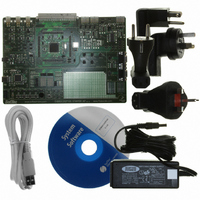EVB9S12XEP100 Freescale Semiconductor, EVB9S12XEP100 Datasheet - Page 515

EVB9S12XEP100
Manufacturer Part Number
EVB9S12XEP100
Description
BOARD EVAL FOR MC9S12XEP100
Manufacturer
Freescale Semiconductor
Type
MCUr
Datasheet
1.EVB9S12XEP100.pdf
(1328 pages)
Specifications of EVB9S12XEP100
Contents
Module and Misc Hardware
Processor To Be Evaluated
MC9S12XEP100
Data Bus Width
16 bit
Interface Type
RS-232
Silicon Manufacturer
Freescale
Core Architecture
S12
Core Sub-architecture
S12
Silicon Core Number
MC9S12
Silicon Family Name
S12XE
Rohs Compliant
Yes
For Use With/related Products
MC9S12XEP100
Lead Free Status / RoHS Status
Lead free / RoHS Compliant
- Current page: 515 of 1328
- Download datasheet (9Mb)
Freescale Semiconductor
Because of an order from the United States International Trade Commission, BGA-packaged product lines and partnumbers
S8C, S4C,
S2C, S1C
FRZ[1:0]
indicated here currently are not available from Freescale for import or sale in the United States prior to September 2010
Field
FIFO
6–3
1–0
2
Conversion Sequence Length — These bits control the number of conversions per sequence.
shows all combinations. At reset, S4C is set to 1 (sequence length is 4). This is to maintain software continuity
to HC12 family.
Result Register FIFO Mode — If this bit is zero (non-FIFO mode), the A/D conversion results map into the result
registers based on the conversion sequence; the result of the first conversion appears in the first result register
(ATDDR0), the second result in the second result register (ATDDR1), and so on.
If this bit is one (FIFO mode) the conversion counter is not reset at the beginning or ending of a conversion
sequence; sequential conversion results are placed in consecutive result registers. In a continuously scanning
conversion sequence, the result register counter will wrap around when it reaches the end of the result register
file. The conversion counter value (CC3-0 in ATDSTAT0) can be used to determine where in the result register
file, the current conversion result will be placed.
Aborting a conversion or starting a new conversion clears the conversion counter even if FIFO=1. So the first
result of a new conversion sequence, started by writing to ATDCTL5, will always be place in the first result register
(ATDDDR0). Intended usage of FIFO mode is continuos conversion (SCAN=1) or triggered conversion
(ETRIG=1).
Which result registers hold valid data can be tracked using the conversion complete flags. Fast flag clear mode
may or may not be useful in a particular application to track valid data.
If this bit is one, automatic compare of result registers is always disabled, that is ADC12B16C will behave as if
ACMPIE and all CPME[n] were zero.
0 Conversion results are placed in the corresponding result register up to the selected sequence length.
1 Conversion results are placed in consecutive result registers (wrap around at end).
Background Debug Freeze Enable — When debugging an application, it is useful in many cases to have the
ATD pause when a breakpoint (Freeze Mode) is encountered. These 2 bits determine how the ATD will respond
to a breakpoint as shown in
may compromise the accuracy of an immediately frozen conversion depending on the length of the freeze period.
V
RH
V
Input Signal
5.120 Volts
RL
= 5.12 Volts
0.022
0.020
0.018
0.016
0.014
0.012
0.010
0.008
0.006
0.004
0.003
0.002
0.000
= 0 Volts
...
Table 13-9. ATDCTL3 Field Descriptions (continued)
Table 13-10. Examples of ideal decimal ATD Results
MC9S12XE-Family Reference Manual Rev. 1.23
Table
(resolution=20mV)
13-12. Leakage onto the storage node and comparator reference capacitors
Codes
8-Bit
255
...
1
1
1
1
1
1
1
0
0
0
0
0
0
Description
(resolution=5mV)
Codes
10-Bit
1023
Chapter 13 Analog-to-Digital Converter (ADC12B16CV1)
...
4
4
4
3
3
2
2
2
1
1
0
0
0
(resolution=1.25mV)
(transfer curve has
1.25mV offset)
Codes
12-Bit
4095
17
16
14
12
11
...
9
8
6
4
3
2
1
0
Table 13-11
515
Related parts for EVB9S12XEP100
Image
Part Number
Description
Manufacturer
Datasheet
Request
R
Part Number:
Description:
Manufacturer:
Freescale Semiconductor, Inc
Datasheet:
Part Number:
Description:
Manufacturer:
Freescale Semiconductor, Inc
Datasheet:
Part Number:
Description:
Manufacturer:
Freescale Semiconductor, Inc
Datasheet:
Part Number:
Description:
Manufacturer:
Freescale Semiconductor, Inc
Datasheet:
Part Number:
Description:
Manufacturer:
Freescale Semiconductor, Inc
Datasheet:
Part Number:
Description:
Manufacturer:
Freescale Semiconductor, Inc
Datasheet:
Part Number:
Description:
Manufacturer:
Freescale Semiconductor, Inc
Datasheet:
Part Number:
Description:
Manufacturer:
Freescale Semiconductor, Inc
Datasheet:
Part Number:
Description:
Manufacturer:
Freescale Semiconductor, Inc
Datasheet:
Part Number:
Description:
Manufacturer:
Freescale Semiconductor, Inc
Datasheet:
Part Number:
Description:
Manufacturer:
Freescale Semiconductor, Inc
Datasheet:
Part Number:
Description:
Manufacturer:
Freescale Semiconductor, Inc
Datasheet:
Part Number:
Description:
Manufacturer:
Freescale Semiconductor, Inc
Datasheet:
Part Number:
Description:
Manufacturer:
Freescale Semiconductor, Inc
Datasheet:
Part Number:
Description:
Manufacturer:
Freescale Semiconductor, Inc
Datasheet:










